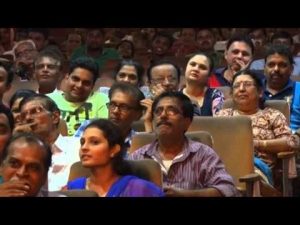The credit of staging Sangeet Natak (musical drame) in the state of Maharashtra goes to Balwant Panduarang Kirloskar (बळवंत पांडुरंग किर्लोस्कर) popularly known as Annasaheb Kirloskar. In the year 1880 Balwant Pandurang staged his first musical play Sangeet Shakuntal. The great tradition started by him has continued till date and it has grown in each style of musical tune, script, outline, and acting. The impact of natya sangeet on the Maharashtrian audience is unwavering.
Natya Sangeet originates from Indian semi-classic and classical music style. Natya Sangeet is lyrics in form of poetries/songs/gazals/nazm which are sung by the actors in a natak (drama). So, musical drams are called Sangeet Natak in Marathi. Natya Sangeet is a form of vocal arts. The other form is Bhavageet. The ragas such as Bhimpalas, Yaman, Jaijaiwanti, Mand, Malkaunsa and others have been used in the music hence the songs are fadeless till date. The Natya Sangeet uses all the classical styles of singing including Khayal Ang, Thumri Ang and light classical forms like Dadra, Tappa and Bhavgeet.
Bhimpalas, Yaman, Jaijaiwanti, Mand, Malkaunsa and others have been used in the music hence the songs are fadeless till date. The Natya Sangeet uses all the classical styles of singing including Khayal Ang, Thumri Ang and light classical forms like Dadra, Tappa and Bhavgeet.
In the early 19th century in Maharashtra, music was solely the union of the rich, aristocratic and royalty of India. Singers were called from all over the country to eneteratin the gathering of rich and royal people. Common people were barred from enjoying classical music. Natya Sangeet emerged essentially so that the common man could also understand classical music and enjoy the classical base. The key difference between Natyageet and Bhavageet is that the latter stresses more on words while the former gives a lot of significance to Raga. Therefore, Natya Sangeet caught popularity with masses in Maharashtra, so much so that during the British Raj they compared it with Operas. Initially, the sangeet natyas were mainly based on mythological stories of Mahabharat and Ramayan which the audience could easily connect with. They did not cover the complete epics but were limited to only small stories in them.
With the rising fame and success of the sangeet natyas, producers started experimenting social issues themes by bringing them to audiences. The example is Sangeet Sharda; this drama was based on the cruel practice of marrying young girls to much elder men, sometimes even widowers in their seventies. The dram portrayed feelings and sentiments of a teenage girl to be married to a widower in his late seventies. The social message of the drama had a great impact on the society. Few dramas, like Kichak Vadh, disturbed the Britishers; they banned this drama because in the drama Kichak was subtly compared to Britishers. Kichak is an evil character from Mahabharata who disgraces Draupadi and the drama was then synonymous with the oppressed common Indian masses.
Similalrly the famous musical drama Ekach Pyala by Ram Ganesh Gadkari depicts the pathetic decline of the alcoholic and the devastating effects his addiction has on his family life. How his family gets devastated because of his addiction.
During the 1960s, yet another transition came in natya sangeet with the entry of Jitendra Abhisheki, who was credited with applying simplicity to the complex composition of Natya Sangeet. He developed a distinct style of rendering Khayal, which is a form of vocal music in which some elements of ṭappā are used. This style was first introduced by Gammu Khan of Banaras. Abhisjki who was originally a khayāl singer, he learnt ṭappā from Shori-miyā. His unique rendition style is known today as the Abhisheki Gharana. Jitendra Abhisjeki was well known for his renditions in Marathi Natya Sangeet compositions like “Guntatá Hrdáya Hai”, “He Suránno Chandra Vhá” and other songs/Marathi ghazals such as “Májhe Jívana Gáne”, “Kaivalyáchya”, “Sarvátmaka sarveshvara”, “Kátá rute kunálá” etc
Natya Sangeet Genius: Narayana Shripad Rajhans, popularly called Bal Gandharva was one of the most iconic Marathi stage actors and singers. The name was bestowed to Narayan by Lokmanya Tilak after listening to his public performance in Pune while he was very young. Gandharva was renowned for his portrayal of female characters in various Marathi plays. He essayed the role of women characters since women were barred from participating in stage plays during that time. Bal Gandharva began his stage career under the mentorship of Annasaheb Kirloskar and first joined his theater company known as Kirloskar Natak Mandali in 1905. It will be unfairness to conclude this article without contribution made by Bal Gandharva to Natya Sangeet.
I list here below some famous Natya Sangeet items:
- Title: Deva Gharche Dnyat Kunala: Album: Matsyagandha Drama: Artist: Ramdas Kamat
2.Title: Ghei Chand Makarand (Raag Salagwarali): Album: Katyar Kaljat Ghusali: Artist: Pandit jitendra Abhisheki
3.Title: Sarwatmaka Sarveshwara: Album: Yayati Devyani: Artist: Pandit Jitendra Abhishki
4. Title: Shura Mi Vandile: Album: Manapman Drama: Artist: Asha Bhosale
5. Marma Bandhatali Thev hi: Album: Sanyasta Khadag: Artist Vasantrao Deshpande













































